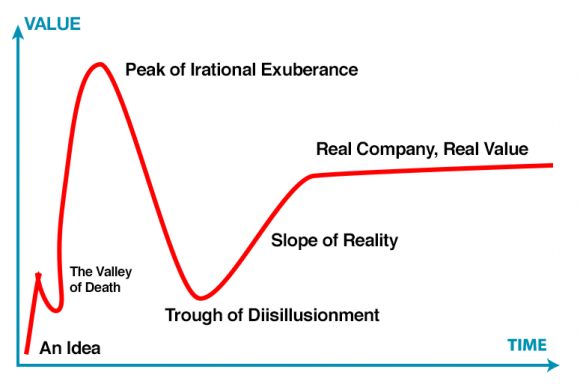
Continuing the discussion of early-stage investing, a common thought circling around the venture capital community is that their the traditional investment model is broken. In “Investing without Zombies”, I focused on the odd choice of optimizing the system for the least likely case. But there is a second flaw in that system as well. Exits.
Traditional equity investments are worthless until a company “exits”. IPOs are finally happening again, but only 222 took this path in 2013, and not all of these were startups. Nearly every other successful early-stage investment for 2013 was due to an acquisition.
Acquisitions, despite the fact that studies have shown that most acquisitions fail.
Given that fact, why would any sane investors structure where the outcome is dependent on an third party who comes along at a random time to value the investment, who often illogically believes this particular acquisition will succeed?
Even if you convince me that the studies are wrong and that acquisitions are mostly successful, that still doesn’t explain why investors would want to wait for an undetermined amount of time, for a happenstance meeting with some new investor, who for whatever reason wants to own the company more than the current investors and founders.
Public equities and commodities do not work this way. If I have a share of public stock, I can sell it any day, for a fairly predictable price (i.e. on most days the price will be within a few percent of yesterday’s listed price). Like private equities, I need a third party to value my shares, but the point of the public market, including the role of specialist or market maker, is to ensure that the third party will be there any and every day.
Traditional debt, meanwhile, works is the completely opposite manner to private equity. Government and corporate bonds comes with a fixed schedule at the time of purchase. There are no third parties in these transactions, making the whole transaction and value completely predictable at the time of the investment.
Looking at investments in this way, I wondered if there was not a structure for early-stage investments that fell in-between private equity and debt. A structure where the investor would not be beholden to a third party, have a better idea of the value of the investment on any given day, and never be sitting around waiting for a random event to trigger the valuation.
As a bonus, I was looking for a structure that worked for cases where the entrepreneurs were happy running their businesses, not seeking to be acquired. Which also happens to better align the interests of investors with entrepreneurs, building value by building sustainable businesses, rather than spending time shopping for acquirers.
Despite the long wish list, I found such a structure.
The answer is revenue-based financing (RBF), also known as royalty-based financing. RBF comes in a variety of forms, but in general it works like this:
- Investors provide $X
- Entrepreneurs use $X to earn $R
- Investors receive Z% of $R, until a total of $2X-$4X is returned
Or in other words, the investors are buying Z% of “top-line revenues” (typically between 3% and 9%) until they are repaid between 2x and 4x the initial investment. Those two values are tuned to provide a reasonable length of repayment, providing a reasonable rate of return (IRR) given the risks of the specific investment.
For early-stage investments, my accelerator Fledge uses 3%-4% of future revenues and a 3x-4x multiple. For growth-stage investments, revenue percentages range from 3%-9% depending on actual revenues, and multiples are typically 2x-3x.
On most measures, RBF falls mid-way between traditional equity and traditional debt. RBF investors do take a risk on future revenues, but no risk waiting for a third party to come along to provide a future value. The value of an RBF investment is predictable in terms of potential cash return, but unpredictable in terms of time, and thus with an unpredictable IRR.
The biggest objection I hear is that it caps the upside of the investment. At Fledge, we overcome that issue by having some equity that is not part of the RBF investment. Thus if some third party really wants one of our companies, we’re just fine with that. And in any case, I find that objection to be a flaw in our current capitalistic system.
Given the advantages, my biggest question is why I’ve found so few other early-stage investors using this structure?















[…] opportunity exists. Second, investors want their money back (and more), and they only way they (think they) can do that is my having the company grow at least 10x in value, necessitating fast […]
Really fascinating! Thanks! Thinking through whether this might work for my company. A few questions. Some of these are probably negotiable, but I’d be curious to know best practices (if there are any).
1) What happens when there are multiple rounds of financing using this method? Will earlier investors see a big dropoff (at least initially) in the amount of each payment because revenue is being distributed across a much larger pool? Or is it additive (e.g. the first round included distributions of X% of revenue and the second included distributions of Y% of revenue, so the company is paying off X% + Y% of revenue until one or both of the rounds is paid off)?
2) In the event of a cash acquisition, do the investors get paid off immediately? What happens if the acquisition is smaller than the amount owed?
3) What happens in the event of a merger? What about a stock acquisition?
I’m sure I’ll have other questions, but that’s it for the moment. Thanks again!
For (2) and (3), the typical terms are immediate and total payment upon a “change of control” of the company.
For (1), the answer is more complicated. Two possible answers. Either (a), there is enough margin for each round to get their own revenue share, or (b) the first investors agree to share some of their revenue share, as the company should grow faster with the new capital. I’ve seen both styles used, but there have not been enough deals to have a most common path.
Thanks! Super helpful. Some additional questions:
1) On the accounting side of things, how do you add the debt to your books? Do you immediately credit the relevant liability account for the full amount owed to the investors (e.g. if you raise $1M and the terms specify a 3x return to investors, do you immediately book $3M in liabilities)?
2) Do you have to do anything special to account for AFRs? I assume there must be some mention of it in the legal documents. Does that affect how you would track the debt (and interest) in your books?
3) If I want to have an employee equity plan (or something of that nature) to help my team feel further invested in the business, what models for that work best with RBF? It seems a typical stock options plan may not make a lot of sense for the same reason we might choose RBF over raising an equity round.
4) I know many startups offer small options packages to advisors. Is there a good alternative to options that might make sense for a business pursuing RBF? I assume whatever it is would be similar to #3 above.
Thanks again for all your help!
1- Debt (or redeemable equity) is a contingent liability, which only appears on the balance sheet once you’ve earned revenue. I’m told that before that revenue is earned its sufficient to list the debt as a footnote.
2- Yes, in the US to ensure a revenue-based loan is considered debt by the IRS and bankruptcy courts, you squeeze in a minimal interest rate and maturity date, even though you don’t aim to ever have to use either.
3- If the goal is not to grow like mad and exit ASAP, a traditional employee options plan makes less sense. Sharing equity is still good, but profit sharing should be looked at too for employee compensations.
4- Given how tiny advisors grants are, this hasn’t come up as important to any of the fledglings or other companies I advise.